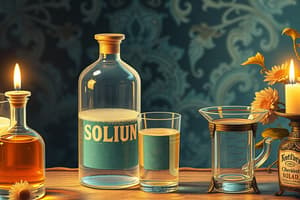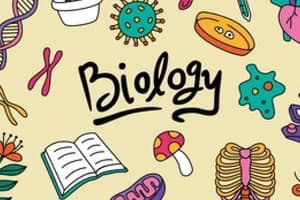Podcast
Questions and Answers
What is Benedict's solution?
What is Benedict's solution?
The substance to be tested is heated with Benedict's solution, which is blue and when heated in the presence of glucose turns orange (brick red). It tests for the presence of glucose in urine, a symptom of diabetes.
What is used to test for simple sugars?
What is used to test for simple sugars?
Benedict's solution is used to test for simple sugars, such as glucose.
What does it mean if Benedict's solution turns orange?
What does it mean if Benedict's solution turns orange?
It indicates the presence of reducing sugars, specifically glucose.
What is used to test for simple sugars?
What is used to test for simple sugars?
How do you test for starch?
How do you test for starch?
Without energy, small molecules move ____
Without energy, small molecules move ____
You need ____ to get something to move against the concentration gradient (low to high).
You need ____ to get something to move against the concentration gradient (low to high).
Lugol test for ____
Lugol test for ____
Benedict's solution and heat tests for?
Benedict's solution and heat tests for?
Flashcards are hidden until you start studying
Study Notes
Benedict's Solution Overview
- Benedict's solution is a reagent used to test for simple sugars, primarily glucose.
- Initially, it appears as a clear blue solution composed of sodium and copper salts.
Testing for Simple Sugars
- When heated in the presence of glucose or other reducing sugars, the solution changes color.
- The transition from blue to orange (brick red) indicates a positive test for glucose.
- The intensity of color change (green, yellow, orange) corresponds to the amount of sugar present.
Significance of Color Change
- An orange color in Benedict's solution signifies the presence of glucose, relevant for diagnosing diabetes.
- The color progression from blue to yellow, and onto orange/brick red, reflects varying sugar concentrations.
Starch Testing
- Lugol's iodine is the reagent used to test for starch.
- In the presence of starch, a blue-black color appears; if absent, the iodine remains amber.
Movement of Molecules
- Small molecules move from areas of high concentration to low concentration without the input of energy (passive transport).
- Energy is required to move molecules against the concentration gradient (from low to high concentration).
Summary of Key Tests
- Benedict's solution: Testing for simple sugars; results in color change based on sugar levels.
- Lugol's iodine test: Identifies starch presence through color change to blue-black.
Studying That Suits You
Use AI to generate personalized quizzes and flashcards to suit your learning preferences.





